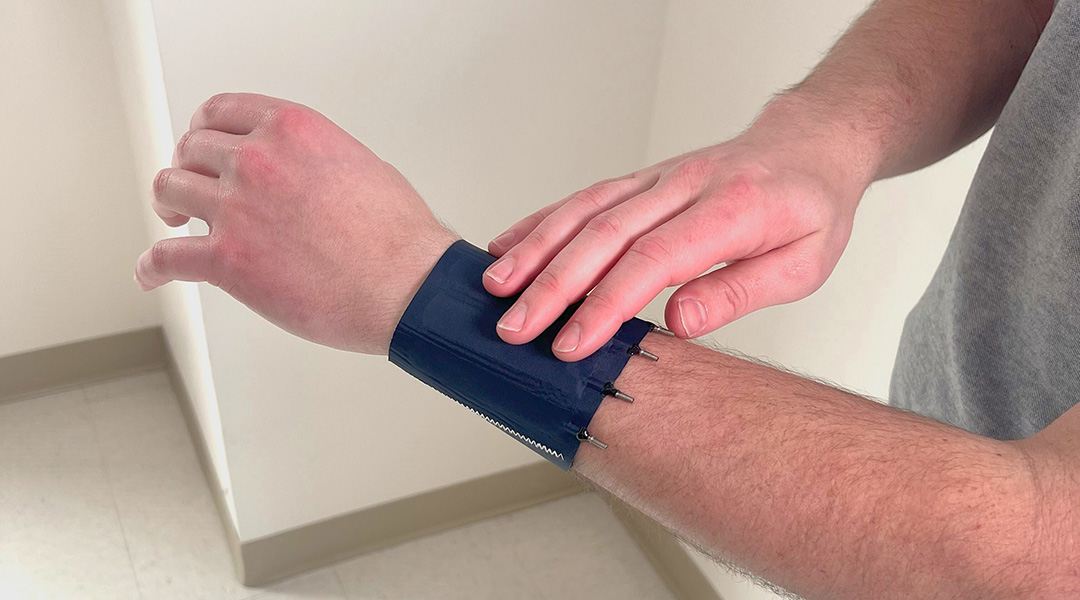A haptic sleeve combines a new kind of on-demand information with soft textiles, taking haptic technology to new levels.
A team of scientists has developed a wearable electronic sleeve that does away with hard parts to provide its users with a deeper and more comfortable haptic experience.
“We developed a wearable haptic sleeve that, when pressurized, applies different levels of squeeze forces around the arm,” said Marcia O’Malley of Rice University and lead author on the study. “The use of fabric as our primary component means that our wearable haptic device is soft, conforming, and comfortable to the user.
“Because we integrate the [wearable’s movement] into the textiles themselves, we can design our devices to apply forces precisely to selected areas of the arm, rather than being constrained by the geometry of off-the-shelf components.”
As electronic devices get smaller and more ubiquitous, the demand for wearable technology has increased, leading to a need for more enhanced sensory experiences and increased physical interaction with digital information.
One issue hindering the widespread use of haptic devices is they generate stimuli using rigid components, like vibration motors, making them uncomfortable to wear. And because most commercially available, off-the-shelf parts aren’t intended to be directly touched by the user, the amount of sensory data they confer via their “haptic cue” is limited.
Textile haptics, like the new sleeve reported by O’Malley and her colleagues, are flexible and conforming, and thus, help avoid these issues. They provide an added “dimension” for the user, by allowing them to choose the depth and detail of their experiences by varying their interaction modes while taking haptic devices way beyond the wrist to the forearm and fingers.
A sensitive haptic sleeve that gives your arm a squeeze
The information the sleeve delivers comes in the form of “squeezes” which are generated by inflatable channels . Varying the number of channels means that different levels of squeezing can be achieved, relaying varying levels of information.
This allows the flexible device to provide body-scale interactions on the forearm and more localized hand-scale interactions on the fingers and palm. O’Malley added that the patterns of inflated channels can encode additional information that the wearer can “read” by simply touching the sleeve with their opposite hand, almost like braille.
Think of this as being like your smartwatch buzzing to inform you that you have a message, and by looking at the screen, you receive the information in the message. The sleeve can squeeze to inform the wearer of something that requires attention and the “reading” of the fabric takes the place of viewing a screen. This is a multi-scale interaction, which, as O’Malley pointed out, takes advantage of the varying sensitivity to touch stimuli in our skin.
“Our arms have a relatively low density of touch receptors in the skin, and so while we can sense squeeze or vibration or pressure on the arm, it can be difficult to discern detailed patterns or to discriminate between two similar stimuli,” the Rice University researcher said. “If we allow the user to actively touch the haptic sleeve with their opposite hand, the higher density of touch receptors in our fingertips allows a user to glean more information from the sleeve by feeling which channels are inflated and what patterns are created.”
The multi-scale nature of the device and its interactions can also be enhanced by the choice of fabric employed as its primary material. This lets the designer create customized patterns that the wearer can feel, and can tune what information is conveyed.
Testing a flexible haptic device
The textile bands that compose the sleeve were created using a computer-numerical controlled (CNC) vinyl cutter that was able to pattern and define the device’s internal and external shape. The team then used a heat press to thermally bond together heat-sealable textiles to form an air-tight, inflatable textile device.
Of course, any wearable system designed for human use can’t be validated until some test subjects have worn it. Thus, the researchers performed a set of experiments using four-channel and eight-channel versions of their sleeves to understand how multi-scale haptic cues, such as the sleeve’s squeezes, are assessed by the wearer. The team then assessed the accuracy of the wearer’s interpretation of the encoded information using the device’s structure.
“We were surprised by how intuitive the system feels. It’s like using a smartwatch, except that after the initial haptic cue alerts you to a message, you actively explore the message with your sense of touch rather than glancing at a screen,” said Dan Preston, another of the study’s authors. “Actively monitoring the device with the hand performed more than 50% better than passively monitoring the device with the arm, but it required the user’s full and continuous attention.”
“We envision that multiscale haptic cues will be particularly useful for applications where a user does not want to devote their attention to monitoring a haptic device continuously but still needs the ability to explore transmitted information in more detail than a conventional passive body-scale device might allow,” Preston added, thus allowing wearers’ to go about their normal routine without the device having to be monitored constantly.
“Our ongoing work aims to combine these embedded controllers with the multiscale haptic cues we studied here to enable intuitive wearables haptic devices that require only minimal supporting infrastructure,” he said.
As for bringing the haptic sleeve to the mass market, Preston pointed out that the team intentionally chose to create their device with scalable manufacturing processes only, so this translation is smooth and natural.
Reference: M.K O’Malley, et al., Multiscale Textile-Based Haptic Interactions, Advanced Intelligent Systems, (2024). DOI: 10.1002/aisy.202300897

